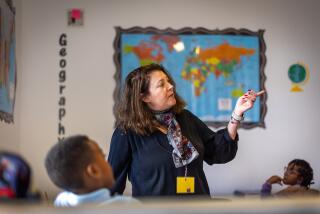‘Good Touch, Bad Touch’ : Children Learn Tactics Against Sexual Abuse
- Share via
The lesson for the day dealt with good touch and bad touch. Candace Gomber, the head teacher at the Lincoln Child Development Center in Santa Monica, used a puppet named Ali to tell a sensitive story about sex abuse to a group of 3- and 4-year-olds:
Little Rosa was spending the night with her baby sitter Tom, a big boy from the neighborhood. Rosa’s mother always told her to mind her baby sitter, but one night Tom told Rosa he would let her stay up late to watch television if she played a secret touching and undressing game with him. Rosa wanted to stay up, but she did not want to take off her clothes and play the touching game.
“Is that game OK?” Gomber asked the children.
“No!” they all shouted.
“What should Rosa say?”
“ ‘No! Stop it!’ ”
“She should tell him, ‘I don’t want anybody touching my private parts,’ “one child said.
“She should tell her mother,” another one blurted.
“Who owns your body?” Gomber asked.
“Me!” they all said.
The 10-minute talk is one of several lessons given each week to children 2 to 5 years old as part of a new “personal safety” curriculum at the center. Parents, teachers and administrators said the program gives young children a means of protecting themselves against sexual molestation.
Gomber said the curriculum does not attempt to teach sex education to preschool children, but to teach them to trust their feeling. “If something doesn’t feel right, they have a right to say no,” she said. “The goal is not to scare children about being touched by adults, but we are trying to help kids develop a healthy sense of intimacy.”
But a healthy sense of intimacy is difficult to define and many experts have words of caution about “good touch, bad touch” programs.
Hershel K. Swinger, director of the state-funded Southern California Child Abuse Prevention Center at California State University, Los Angeles, said, “They are asking children to make sophisticated judgments based on their perception of the touch.
“We don’t want them to be so fearful of adults that they don’t develop natural human feelings and respect for adults. We also know that most of the sexual abuse is not done by strangers, but by family members, but I don’t think anyone is willing to say don’t let a family member touch you.”
Reports Required
Charles Pace, the coordinator of Saint John’s Hospital and Health Center’s child abuse treatment program, introduced the curriculum to parents and teachers last year at the Lincoln and John Adams Child Development centers, which are part of the Santa Monica-Malibu Unified School District. The two preschool child-care centers have a combined enrollment of more than 100 children.
Teachers, who are required by law to report all suspected cases child molestation to police or child protective agencies, need training in how to identify and handle such cases, he said. It is a problem that few people have been able to discuss openly.
“Most schools teach where a child’s hand is and his head, but nothing about the genitals,” Pace said. “Children need to feel comfortable expressing themselves and using words like penis and vagina.”
Pace introduced the teachers to the program through a series of seminars during the summer. Parents were given lectures in November and the children started their lessons last month.
The lessons are presented as simple stories told by a puppet, illustrated with pictures and concluded with discussion. Children are taught how to determine a good touch from a bad touch, how to say no and the importance of reporting the incident.
The curriculum is divided into three major areas:
- The “touching” unit teaches children how to distinguish between a good touch and a bad touch. Children are taught the difference between touches that make them feel good, such as hugs, kisses and pats on the back, and those that make them feel bad or confused--hitting, spanking and pushing. The children are told that someone else touching their “private parts” is bad touch. Their private parts are defined as the area of their bodies covered by a swim suit.
- The “saying no” segment teaches them that they have a right to say no if they don’t like what they feel. “It teaches them how to be assertive if they feel their rights have been violated,” Pace said. “If they don’t like it, they should feel entitled to say no and not have an adult affront their authority.”
- The “telling” unit teaches children to report bad touches to their teacher or parents. “They should continue to talk about it until they find someone who will listen,” Pace said.
Dr. Michael Durfee, a child psychiatrist who coordinates the county Health Department’s child abuse prevention program, said he was in favor of the program, but warned that “it’s a simple formula that some people feel is going to stop a complex problem.
“There are a couple of problems with the program,” he said. “It puts the burden on the child, making the children responsible for their own protection. That is important, but we must not back off other efforts too. The other drawback is that in the name of avoiding evil teachers we are stopping the touching of children. It is a double-edged sword.
Question of Focus
“The fact is that good touch, bad touch programs tend to focus on bad touch. They don’t spend enough time on the importance of sitting on a parent’s lap, tucking a child in at night or touching them when you are talking to them.”
Suzanne Abrescia, a preschool teacher at the center, said that the lessons taught in the personal safety curriculum apply to other aspects of life. “They got the idea of good touch, bad touch right away,” she said. “In the playground, I would hear them say, ‘That’s bad touch,’ when one child hits another.
“It is not just to stop sexual abuse, but to help children become more assertive in life. The private parts of your body are no different from other parts. They are all yours.”
School board member Peggy Lyons said the program is a good one. “I think young people are very vulnerable and perhaps they should have simple ways to recognize the problem,” she said.
“Given the problem with sexual abuse, children need to become more aware of this,” Connie Jenkins, another school board member. “It is very important for children to understand how to protect themselves and have a sense of support. So that if something makes them feel bad, it’s bad.”
Several parents of children at the Lincoln Development Center said they appreciated the program.
‘Too Friendly’
Cheryle McKneely said the program was helpful because her 3-year old daughter was frequently too friendly with strangers.
“Once I had to stop her from accepting candy from a stranger,” she said. “But now she understands the concept. She told me that she learned it was ‘not good to hit or call someone dumb-dumb to hurt someone’s feelings, it’s not good to touch me under my clothes.’ I said that is right.”
“I don’t know how to talk to a 4-year old about molestation,” said Micahel Abbott, the father of Erin, 4. “Sometimes Erin’s older sister hits her. Erin has picked up on the fact that if you don’t want someone touching you in a certain way, you speak up. So she says, ‘It’s my body, I don’t want you doing that.’ ”
Bette Shapiro, the mother of 3-year-old Jared, said, “I was concerned because I didn’t want him to be afraid of people, but I also wanted him to know that there are people out there who do bad things.”
Shapiro said her son decided to practice what he learned in class one evening while taking his bath. “He said ‘No!’ He didn’t want me to bath him. He said ‘It’s my body and it belongs to me.’ He never did that before.
She said, however, that when Jared realized that he would still have to take a bath, regardless of who washed him, he allowed her to bathe him.
“I’m a single parent, so all the responsibility in this particular area is on me,” she said. “I was grateful to have the school participate. I found it extremely supportive.”
More to Read
Sign up for Essential California
The most important California stories and recommendations in your inbox every morning.
You may occasionally receive promotional content from the Los Angeles Times.










